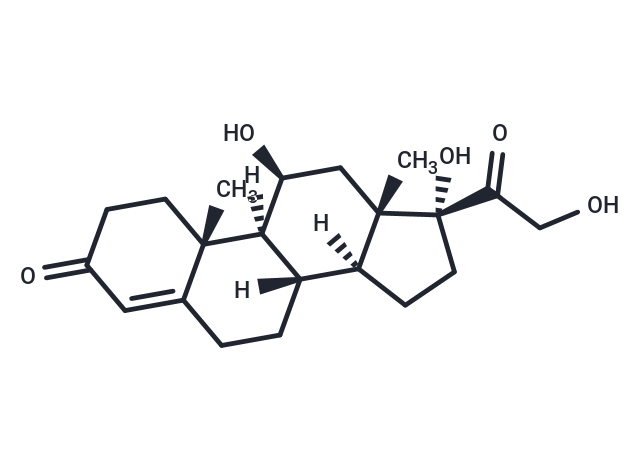Shopping Cart
- Remove All
 Your shopping cart is currently empty
Your shopping cart is currently empty

Hydrocortisone (Cortisol) is a glucocorticoid hormone secreted by the adrenocortex. Hydrocortisone agonizes the glucocorticoid receptor, which promotes proteolytic metabolism, gluconeogenesis, capillary wall stabilization, and renal calcium excretion, as well as suppressing immune and inflammatory responses.

| Pack Size | Price | Availability | Quantity |
|---|---|---|---|
| 50 mg | $30 | In Stock | |
| 1 mL x 10 mM (in DMSO) | $50 | In Stock |
| Description | Hydrocortisone (Cortisol) is a glucocorticoid hormone secreted by the adrenocortex. Hydrocortisone agonizes the glucocorticoid receptor, which promotes proteolytic metabolism, gluconeogenesis, capillary wall stabilization, and renal calcium excretion, as well as suppressing immune and inflammatory responses. |
| In vitro | METHODS: Human articular chondrocytes were cultured in medium containing Hydrocortisone (0.05-1.0 μg/mL), and the relevant indexes were measured by Flow Cytometry. RESULTS: The catabolic signaling pathway of chondrocytes treated with 0.05 μg/mL Hydrocortisone was reduced, and the ability to synthesize ECM macromolecules was enhanced. [1] METHODS: Porcine brain capillary endothelial cells PBCEC were cultured with medium containing Hydrocortisone (550 nM) for seven days, and the cytoskeleton was examined using fluorescence microscopy. RESULTS: Hydrocortisone-induced cytoskeletal rearrangement. [2] |
| In vivo | In ex vivo guinea pig hearts, Hydrocortisone reduces post-ischemic oxidative stress, perfusion pressure, and effusion formation. Within the human cerebral microvascular endothelial cell line hCMEC/D3, Hydrocortisone prevents endothelial barrier disruption induced by pro-inflammatory stimulation (administration of TNFα), partly by maintaining occludin levels. Hydrocortisone induces class-switch recombination from Sμ to Sε in IL-4-treated B cells, supporting a model for sequential isotype transformation from IgM to IgE through IgG4. Following dendritic cell treatment, Hydrocortisone decreases the expression of MHC class II molecules, the dendritic-specific marker CD83, and costimulatory molecule CD86, while significantly reducing IL-12 secretion. Additionally, it inhibits the increase of IL-4 (induced by IFN-γ) but does not affect IL-5. Hydrocortisone lowers T cell proliferation in dendritic cells. It prevents TNF-α-induced severe degradation of glycocalyx, increases in coronary resistance, vascular leakage and permeability, hydroxyethyl starch, and causes degranulation of mast cells in ex vivo guinea pig hearts. Hydrocortisone inhibits the shedding of multiligand glycosaminoglycans-1, heparan sulfate, and hyaluronic acid post-ischemia and suppresses the release of histamine from resident mast cells. |
| Cell Research | Cells are plated on top of collagen IV-coated transwell chambers for six-well plates (24 mm diameter, membrane material: polyethylene terephthalate (PET), 0.4 μm pores, pore density 1.6×106?cm2) at densities of 2.5×104?cells cm2?per well. When they have reached confluence at day 5, the different experimental sets of cells are transferred to differentiation medium containing reduced amounts of FCS and treated with TNFα or hydrocortisone as indicated. |
| Alias | Cortisol |
| Molecular Weight | 362.46 |
| Formula | C21H30O5 |
| Cas No. | 50-23-7 |
| Smiles | C[C@@]12[C@]([C@]3([C@@]([C@]4(C)C(CC3)=CC(=O)CC4)([C@@H](O)C1)[H])[H])(CC[C@@]2(C(CO)=O)O)[H] |
| Relative Density. | 1.28g/cm3 |
| Storage | keep away from direct sunlight | Powder: -20°C for 3 years | In solvent: -80°C for 1 year | Shipping with blue ice. | |||||||||||||||||||||||||
| Solubility Information | DMSO: 50 mg/mL (137.95 mM), Sonication is recommended. Ethanol: 22 mg/mL (60.7 mM), Sonication is recommended. 10% DMSO+40% PEG300+5% Tween 80+45% Saline: 6.8 mg/mL (18.76 mM), In vivo: Please add the solvents sequentially, clarifying the solution as much as possible before adding the next one. Dissolve by heating and/or sonication if necessary. Working solution is recommended to be prepared and used immediately. | |||||||||||||||||||||||||
Solution Preparation Table | ||||||||||||||||||||||||||
Ethanol/DMSO
DMSO
| ||||||||||||||||||||||||||

Copyright © 2015-2025 TargetMol Chemicals Inc. All Rights Reserved.